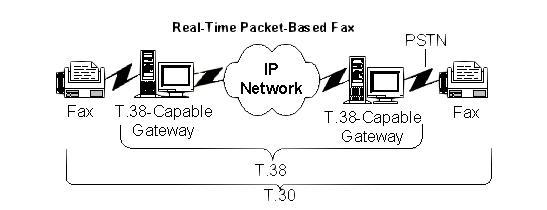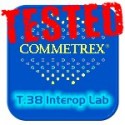The industry-leading T.38 fax relay software from Commetrex provides the ATA or gateway OEM the highest-performing T.38 fax relay software for use in IP networks. T.38 fax relay software from Commetrex supports data and controls redundancy, meets the ITU-T recommendations, and supports proprietary protocols for secure-fax applications by converting data to an audio stream, which greatly reduces the effects of packet loss.
T.38 Fax Relay Software

Smart FoIP®, the patented technology from Commetrex, is optionally available with T.38 fax relay software for use in SIP networks. Smart FoIP eliminates the problems caused by late-arriving T.38 re-INVITES from the receiving gateway that can cause the call to fail if incorrectly accepted by the calling gateway.
Commetrex has found that significant practical problems with SIP negotiations exist in carrier-based SIP networks. After much testing and analysis, we have developed what we call “Smart FoIP”, which improves the reliability of fax-session establishment for ATAs and access gateways. The technology increases the likelihood of a session remaining in G.711 fax pass-through mode, so it also includes a new technology that eliminates PCM-clock synchronization problems.
Features of T.38 Fax Relay Software
- Exclusive Smart FoIP technology
- Support for ITU T.38 Version 3 with V.34 Fax Relay Real-Time Fax over IP
- Support for ITU I. 366.2 fax over ATM AAL2
- Support for MPLS and Frame Relay Alliance FRF.11.1
- Interop proven in the “T.38 Fax Relay Interoperability Lab”.
- UDP/TCP support
- Forward error correction
- UDP Redundancy
- ECM support
- Five seconds round-trip delay
- Fax-aware jitter-buffer management
- V.27ter, V.29, V.17
- 10+ years of field experience
- Hardware independent
- Portable ANSI C code
- Object- or Source-Code Licenses
Benefits of T.38 Fax Relay Software
- Broad market coverage
- Operates in IP-carrier networks
- Operates in geosynchronous satellite networks
- High customer satisfaction
- Quick-to-market
- Wide selection of targeted transports
- Resource and vendor independent
- Low product-development costs
- Low maintenance costs
- IP-based unified messaging
- Dedicated POTS lines for fax can be dropped when using Smart FoIP ATAs

T.38 Interoperability
In 2002-2004 Commetrex provided the telecommunications industry an interoperability testing service, the T.38 Interop Lab, that used TerminatingT38 as the interoperability reference standard. This very successful Commetrex initiative formed the foundation of TerminatingT38’s industry-leading interoperability. As the inventor of terminating T.38 technology in 2001, TerminatingT38 boasts a longer in-market service than any product. Since then, virtually the entire IP-test-equipment market has standardized on Commetrex’ T.38.
T.38 Fax Relay Software Technical Overview
 The core module of T.38 Fax relay software is a Protocol Engine (PE) that implements the algorithm that controls the sequencing of modems and the transfer of signals across the data link. (See diagram below.) It also implements protocol ‘spoofing’, as required, to handle the delay objective for the implementation. Spoofing refers to the logic implemented in the PE that modifies the protocol commands and responses to keep network delays from causing the transaction to fail. This is done, for example, by padding image lines or deliberately causing a message to be re-transmitted to render network delays transparent to the sending/receiving fax terminals.
The core module of T.38 Fax relay software is a Protocol Engine (PE) that implements the algorithm that controls the sequencing of modems and the transfer of signals across the data link. (See diagram below.) It also implements protocol ‘spoofing’, as required, to handle the delay objective for the implementation. Spoofing refers to the logic implemented in the PE that modifies the protocol commands and responses to keep network delays from causing the transaction to fail. This is done, for example, by padding image lines or deliberately causing a message to be re-transmitted to render network delays transparent to the sending/receiving fax terminals.
For a system that can tolerate up to five seconds of round-trip link delay, a stimulus-response relay will suffice. For longer delays, more complex algorithms are required.
As can be seen from the diagram below, the Fax Relay includes two data paths controlled by the PE. The Demod path demodulates fax signals from the PSTN, modifies the signals as required, and passes them to the Encoder. The Encoder formats the signals and data for transmission over the data link.
The Remod path first extracts signals and data from the data link. Signals are passed to the PE to control operations. T.30 data are modified as required and passed to the V.21 rate adapter and subsequently to the V.21 transmitter. Image data are passed directly to the HS (high-speed) rate adapter for the current mode and subsequently to the operating transmitter.

The PE takes the event inputs from the Demod and Remod paths along with timer events. Based on these inputs the PE commands the modems and forwards signals to the data link.
Less than 3.45 Seconds
The T.30 protocol is designed to handle 3 seconds +/- 15% of delay. In practice, fax terminals implement the 3.45 seconds as the timeout. This is intended to deal with normal network (PSTN) delays and internal fax-terminal processing delays. So, the fax relay need not provide any protocol spoofing to handle this level of delay.
3.45 to 5.0 Seconds
In order to extend delay tolerance to 5.0 seconds, the PE makes use of two aspects of T.30, one to handle V.21 signaling; the other is implemented during image transfer.
First, the minimum preamble of a V.21 signal is defined to be one second +/- 15%. In practice, most fax terminals utilize 0.85 seconds. However, the maximum duration of the preamble is limited by the limit placed on the length of a frame. This is specified as 3.0 seconds from the receipt of a flag until a complete frame is received. Depending on whether the unit is a calling fax or called fax, the largest possible frame ranges from 6 octets (simple command or response) to NSF/NSS/NSC of unknown length.
A simple frame of 6 octets has a maximum preamble of 106 flags, or 2.8 seconds. In the case of NSF/NSS/NSC, fax relay suppresses these frames and can replace them with a frame of known length. If that length is chosen to be 20 octets, the preamble can be stretched to 2.16 seconds or 81 flags. The only other case that provides difficulty is the handling of the PPR (Post Page Response) frame. This frame has a fixed length of 38 octets or 1.2 seconds, allowing for worst-case padding. This leaves a maximum preamble of 1.8 seconds. Thus, in all cases the preamble can be stretched to 1.8 seconds at the low end to 2.8 at the high end.
When the PE expects a V.21 frame from its network partner a timer is set waiting for the V.21 carrier signal. If the timer expires, the T.38 Fax Relay starts transmitting the V.21 preamble. It then sets a timer for the maximum allowable preamble duration based on the expected frame. If the V.21 data are received prior to the timeout, the timer is canceled and the relayed V.21 message is queued for transmission. If the V.21 message is not received in time, a CRP frame or a short frame with error is queued, causing the opposite terminal to retransmit.
For image-transfer operation, a similar technique is used. The Receiving Fax will wait up to 6 seconds for the start of the high-speed image transmission, requiring no further intervention to handle a 5-to-7-second network delay.
Greater than 5 Seconds
Delays greater than five seconds require that the two relay entities perform independent T.30 sessions with the two terminals. These independent sessions are loosely coupled and require much more data buffering than systems requiring less delay tolerance.
“Demod” T.30 Processing Component
The Receiving Relay performs the following functions:
- Strip preamble flags and CRC result octets.
- NSS/NSF/NSC frame suppression.
- Track DCS parameters of minimum line length, encoding, and ECM mode.
- Modify DIS minimum line length (Optional)
- Suppression of 2400bps signaling. (Obsolete but still deployed)
- Frame-type extraction and event generation.
The Receiving Relay component (RRC) determines the frame type and passes this frame type as an event to the relay protocol engine after the frame is complete. The Transmitting Relay Component (TRC) converts T.30 frames received from the Transmitting Fax events for the PE.
The Padding Removal Component removes minimum line-length padding from received data. The HS Rate Adapter for 1-D and 2-D encoding will reinsert the padding bits, as required, at the transmitter. This function allows the Fax Relay to force the effective fax data rate to be less than the data link rate, even when the nominal modem rates are the same. For example, if the data link used for relay is V.32bis operating at 14,400, the Fax Relay can force the TF to transmit padded lines by modifying the DIS parameters. The RR removes the padding, resulting in an effective data rate lower than the 14,400bps rate of the data modem in order to adjust for slight differences in data rate.
Modem Subsystem Components
The PE’s primary job is to start and stop modems and to pass events detected on the PSTN line as signals over the data link. The Modem Controller Component controls the operation of the modem components. It starts and stops modems based on commands from the PE. It sequences the operation of the various modem components.
The V.21 Rate Adapter component accepts a T.30 octet stream as input. The package inserts the preamble, possibly increasing its length if data are not available. This package also buffers T.30 data to enable it to insert extra flag characters – as required to handle late arriving packets.
HS Rate Adapter Component
The HS Rate Adapter component consists of three separate rate adapters based on the format of the image data. The three rate adapters are:
- ECM
- 1-D Image
- 2-D Image
The rate adapters provide padding to handle late-arriving data from the data link. The type of padding varies with the high-speed data, requiring three versions. The 1-D and 2-D adopters also ensure minimum line length.
Encoder Component
The Encoder Component converts signals, T.30 data, and high-speed data for transmission over the data link. It handles any packetization required and any fill bits required to fill a synchronous data link.
The PE can be designed to handle various data-link delays. PowerRelay supports various versions of the PE to account for various delays.
Construction Options
- Disable ECM (reduces memory and MIPS)
- Disable V.17 fax (reduces memory and MIPS)
- Redundancy/FEC size
- Control of jitter buffer
- Variable execution size (processing intervals of 5, 10, 20, or 40-milliseconds)
- A-law or µ-law
- Runtime ECM disable (Disable ECM on a call-by-call basis to dynamically conserve MIPS on an oversubscribed system.)
FoIP Interoperability
 Commetrex has led the industry effort for T.38 interoperability since January 2002, when it launched the T.38 Interoperability Test Lab. Recently, Commetrex has done extensive interoperability testing with the BladeWare HMP telephony platform, with international carriers, service providers, and enterprises.
Commetrex has led the industry effort for T.38 interoperability since January 2002, when it launched the T.38 Interoperability Test Lab. Recently, Commetrex has done extensive interoperability testing with the BladeWare HMP telephony platform, with international carriers, service providers, and enterprises.
T.38 Fax Relay Ordering Information
- PowerRelay Basic – PN 60316
- PowerRelay T.38 Fax Relay – PN 60318 (requires 60316)
- Smart FoIP – PN 60325
- PowerRelay I.366.2 – PN 60320 (requires 60316)
- PowerRelay FRF.11.1 – PN 60321 (requires 60316)
- V.34 Fax Modem – PN 60142
- Fax Modem Bundle – PN 60112
See a list of our customers who use T.38 Fax Relay Software.







